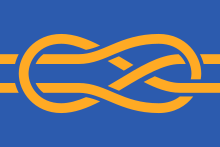Vexillology

Vexillology(/ˌvɛksɪˈlɒlədʒi/VEK-sih-LOL-ə-jee) is the study of the history, symbolism and usage offlagsor, by extension, any interest in flags in general.[1]
A person who studies flags is avexillologist,one who designs flags is a vexillographer, and the art of designing flags is calledvexillography.One who is a hobbyist or general admirer of flags is a vexillophile.
Etymology[edit]
The word vexillology is a synthesis of the Latin wordvexillum(a kind of square flag which was carried by Roman cavalry)[2]and the Greek suffix-logia( "study" ).[3]
History[edit]
This sectionneeds expansion.You can help byadding to it.(March 2018) |
American scholarWhitney Smithis acknowledged as conceiving the term "vexillology" in 1957. He wrote "while the use of flags goes back to the earliest days of human civilization, the study of that usage in a serious fashion is so recent that the term for it did not appear in print until 1959."[4][5]Before this time, the study of flags was generally considered a part ofheraldry,the study of armorial bearings.[6]
Vexillology was formalized by American scholar Smith in 1961 with the publication ofThe Flag Bulletin.[7]During his lifetime, Smith organized various flag organizations and meetings including the firstInternational Congress of Vexillology(ICV), theNorth American Vexillological Association,and theInternational Federation of Vexillological Associations(FIAV).[8]
Involvement in vexillology includes academic work in fields such associology,history, or design. It also includes contributions from the flag industry and interest from those passionate about flags. The ICV and local vexillological meetings often cover a wide range of interests in flags. Since 1969, an International Congress of Vexillology meeting has been organized every two years under the auspices of FIAV; papers presented at an ICV are published afterwards as the Congress'sProceedings.[7]
Vexillological organizations[edit]
The International Federation of Vexillological Associations (FIAV) is vexillology's international umbrella organization. Notable constituent organizations include theNorth American Vexillological Association,Deutsche Gesellschaft für Flaggenkunde(English: 'German Society for Flag Studies'), andFlags of the World(FOTW).[9]
Flag Design[edit]
Vexillology studies many complex and multifaceted areas of flag design.
One such area is what makes a flag truly a good symbol of the area it represents. Ted Kaye has outlined five basic rules of Vexillology that constitute "good" and "bad" flag designs.[10]These rules are outlined in his book, titledGood Flag, Bad Flag.The book is meant to be "a quick reference and primer for anyone interested in vexillography or who wants to create a flag" according to the North American Vexillological Association.[10]
The rules are as follows:
- Keep It Simple.Children should be able to draw a "good" flag with relative ease.[10]For example, theflag of Francewould follow this rule, while theflag of Belizewould not.
- Use Meaningful Symbolism.The colors, design, and elements of a "good" flag should represent some aspect of the place they represent.[10]For example, theflag of Canadais said to represent pride and strength throughout the history of Canada.[11]
- Use 2 or 3 Basic Colors.Flags that employ too many colors risk being chaotic, so two or three colors from the standard set of colors (i.e. red, green, white, etc.) that work together well should be used.[10]In some cases, flags can use many more colors and still work, like theflag of South Africa.
- Avoid Lettering or Seals.Use of seals and lettering harm the simplicity and distinctiveness of a flag. They should be avoided.[10]
- Be Distinctive or Be Related.First and foremost, a flag is a symbol to identify an area, so it should be distinct and recognizable. However, including similar design elements to other flags, such as theNordic Cross,can help convey a sense of unity among places.[10]
It should be mentioned that all of these rules are meant to be general suggestions rather than laws of design, and exceptions to these rules do exist.
See also[edit]
- Glossary of vexillology
- List of flags by design
- List of national flags by design
- List of vexillologists
- Vexilloid
- Vexillological symbol
- Good Flag, Bad Flag
References[edit]
- ^Smith, Whitney.Flags Through the Ages and Across the WorldNew York: McGraw-Hill, 1975. Print.
- ^"Vexillum".Merriam-Webster Online Dictionary.Archivedfrom the original on 16 September 2020.Retrieved15 September2020.
- ^"Vexillology".Dictionary.Retrieved2024-02-22.
- ^"Vexillology".CRW Flags.Archivedfrom the original on 2016-10-24.Retrieved2017-11-03.
- ^"Vexillology".Merriam-Webster Online Dictionary.Archivedfrom the original on 17 September 2020.Retrieved15 September2020.
- ^Fox-Davies, Arthur Charles (1909).A Complete Guide to Heraldry.London, Edinburgh: T.C. & E.C. Jack. p. 1.ISBN9781602390010.OCLC913797670.
- ^ab"Consider Vexillology".semioticon – SemiotiX.Archived fromthe originalon 2018-04-01.Retrieved2018-04-01.
- ^Vulliamy, Elsa (December 15, 2015)."Which flag is it? Take our quiz to find out".The Independent.Archivedfrom the original on 2022-08-17.RetrievedMarch 13,2016.
- ^"Current Members".International Federation of Vexillological Associations.2022-10-16.Archivedfrom the original on 2021-04-18.Retrieved2023-02-17.
- ^abcdefg"Good Flag, Bad Flag - North American Vexillological Association".nava.org.Retrieved2024-06-05.
- ^Heritage, Canadian (2017-09-11)."National flag of Canada".canada.ca.Retrieved2024-06-05.
Further reading[edit]
- Leepson, Marc.Flag: An American Biography.New York: Thomas Dunne Books, 2005.ISBN0312323093.
- Marshall, Tim.A Flag Worth Dying For: The Power and Politics of Flag.2016.ISBN1501168347.



